Bamboo Flooring: Our Handy Guide
It’s often thought that bamboo flooring is just another type of hardwood. Yet, its differences and benefits are quite something. In this post, we discover what makes bamboo unique and why it’s such an appealing choice of floor for the home. The guide covers everything you need to know about the flooring including where it’s from, the types available, how it’s finished and how you can incorporate the style into your traditional or contemporary space.
What is bamboo?
Let’s start with a fact that might be surprising: bamboo isn’t a wood but a grass. And it’s not your typical type of grass either. The plant is super strong and super quick-growing. In fact, it reaches its peak height of 20 metres within just a couple of months, growing at amazing speeds of up to 1 metre a day during its growth season. The stem is fully matured and ready for harvesting within just 4-5 years making bamboo the fastest growing plant on our planet and one of the most renewable resources available.
But you might be thinking how can a grass possibly be strong enough for flooring? Although you’d normally associate grass with the soft and flexible green plant that spreads over our garden lawns and fields, bamboo is a much different material. Once fully matured, the plant acquires characteristics that are very similar to hardwood, becoming a highly durable material that offers even better stability than many wood floors. Bamboo’s intrinsic hardness means it can be used to make some of the strongest materials in the world including bridges, houses, furniture and of course, bamboo flooring.
Basically, bamboo combines the merits of hardwood with an astounding growing capacity, making it an all-round awesome material.
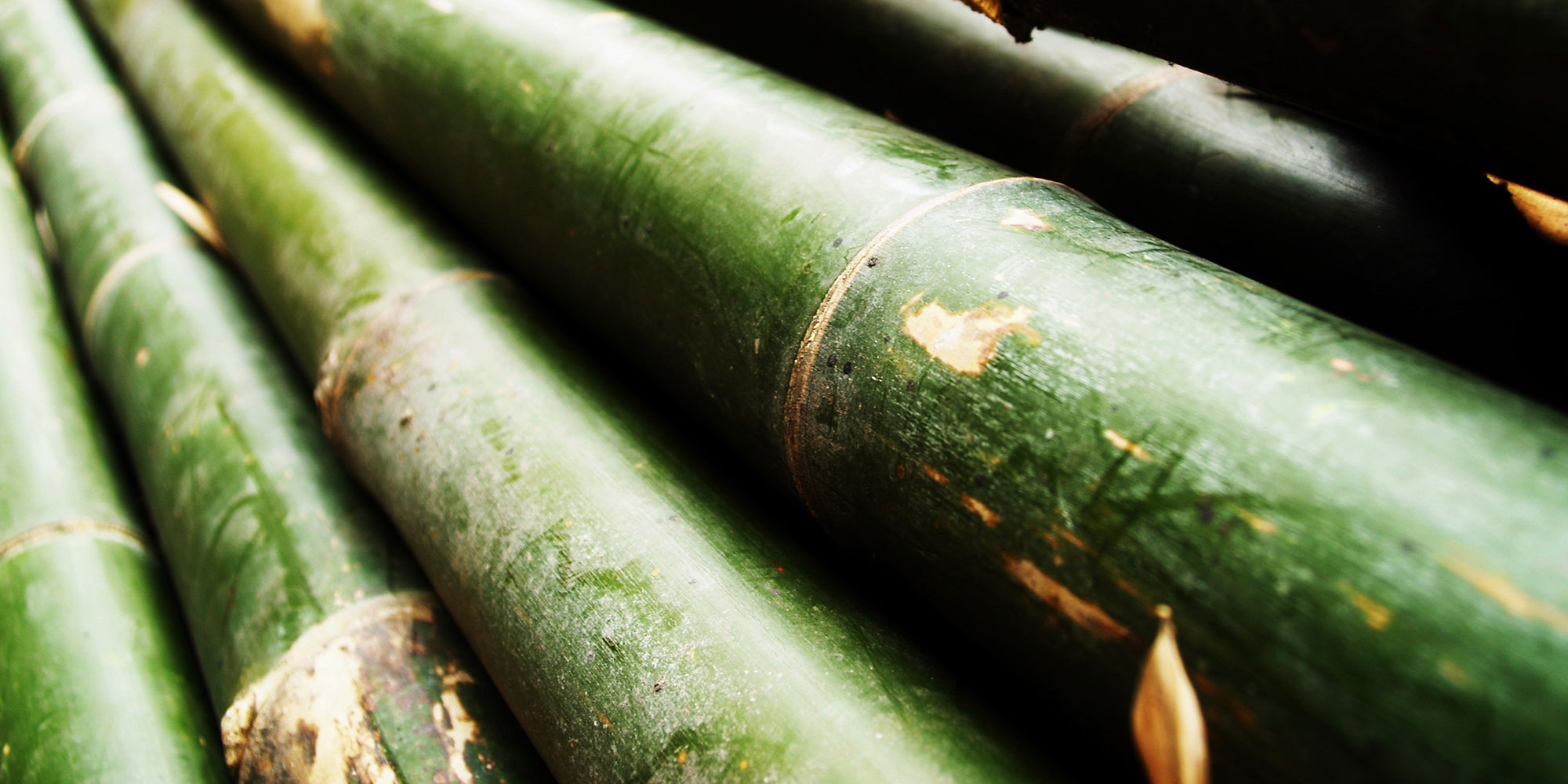
Where does bamboo flooring come from?
There are more than 1500 species of bamboo native to 5 continents of the world: Africa, Asia, South America, North America and Australia. The plant also grows in Europe after being introduced in the 1800s, leaving Antarctica as the only continent where the plant isn’t found.
Although bamboo populations are in abundance, only one species is truly suitable for flooring. This grows mainly in China and is called the ‘Phyllostachys Pubescens’ or is known as the Moso bamboo. It’s from these highly robust and accessible forests that Woodpecker bamboo flooring is sourced.
What about the pandas? Is bamboo flooring a threat to them?
It’s true that a panda’s diet consists almost entirely of bamboo. In fact, the plant is such a poor source of nutrition that the animal often needs to eat up to 20kg of bamboo every day, which can take up to 16 hours! Yet the Moso species of bamboo that we harvest for flooring doesn’t grow in the animal’s habitat and even has inaccessible leaves. Pandas live in the Central mountain ranges of China where they feed on smaller bamboo species with leaf growth on the lower areas of their stems. This means Woodpecker bamboo flooring poses no threat to the panda!

How is bamboo flooring made?
As bamboo is a hollow plant, the manufacturing process for flooring is significantly different to that typical of hardwoods. After the bamboo has been harvested, the green outer-hull is removed from each of the canes to access their inner stalks. This part of the plant is then cut into long strips known as fillets and these are milled on their outer sides to remove their natural curvature and create more versatile flat strips. The strips are then dried and boiled to remove moisture, natural sugars and starches.
There are two main benefits of the boiling process:
- The bamboo is less desirable to certain insects that can tend to infest the plant. This is a key benefit to homes in tropical locations that are prone to termite infestations.
- The bamboo is less likely to suffer expansion and contraction with humidity changes.
After the bamboo strips have been prepared, they can then be manufactured into one of two types of bamboo flooring. The waste fibres produced from milling the edges of the fillets doesn’t go to waste either but is used to create another different type of bamboo flooring…
What are the types of bamboo flooring?
There are three different types of bamboo flooring: laminated vertical, laminated horizontal or strand-woven. Each of these are produced differently, have a different look and varying benefits.
Vertically Laminated Bamboo Flooring

As shown in the diagram above, vertically laminated bamboo flooring consists of strips of bamboo which are bonded together at a vertical angle. The result is a narrow grain pattern which shows clear definition between each strip in the board but doesn’t display the natural nodes and patterns in the bamboo.
The overall appearance is uniform and consistent which usually makes this type of bamboo flooring a preference for modern interiors or vibrant themes that fit with an understated base.
Horizontally Laminated Bamboo Flooring
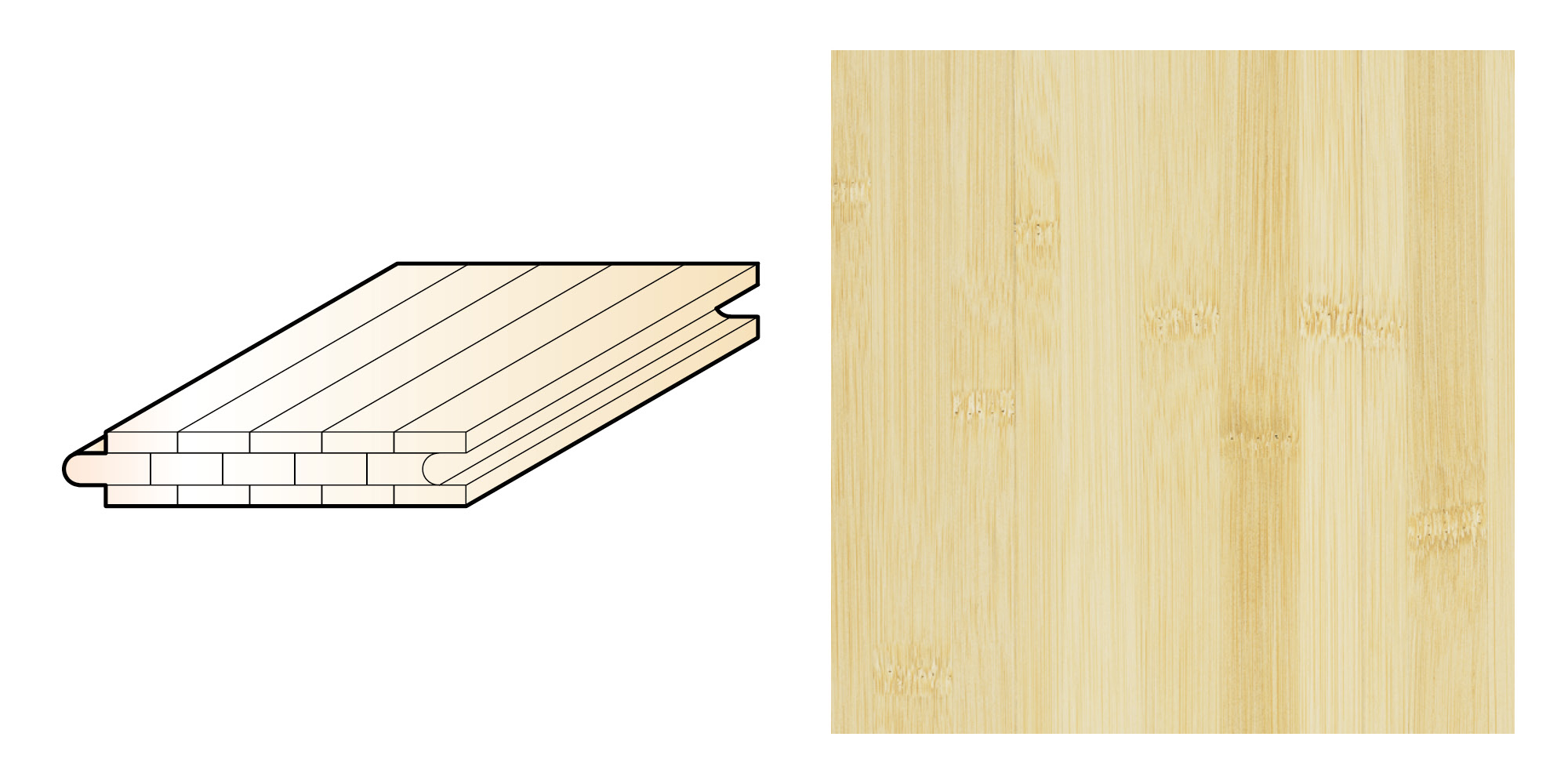
Horizontally laminated bamboo flooring is produced from strips of bamboo bonded together at a horizontal angle, revealing a wider grain pattern which shows the natural knuckles and growth rings in the bamboo more clearly than the vertical alternative. This type of bamboo is often described as having a more natural appearance as it shows the unique intricacies and shape of the bamboo cane.
To create planks that are thick enough to be used for flooring, three layers of the horizontally bonded flat strips are glued together, as shown in the diagram above.
Aside from appearance, the vertical and horizontal types of bamboo flooring are very alike in practicality. Each type has a similar hardness to oak flooring and is suitable for laying over underfloor heating. Both types are regarded as traditional simply because they represent the first ways in which bamboo flooring was made.
Woodpecker horizontal and vertical bamboo floors are finished with 5 coats of UV Urethane for protection, durability and style. Discover them in our Oxwich collection.
Strand Woven Bamboo
Strand woven is considered a more contemporary type of bamboo flooring as it has evolved from the original manufacturing techniques to accommodate extra hardness and durability. This type of flooring is produced by coating raw bamboo fibers (the ‘waste’ fibers from milling bamboo fillets) in resins and then compressing these strips together under extreme heat and pressure. The compressed material is then transformed into flooring planks which are twice as hard as vertical or laminate constructions and one of the hardest types of natural flooring available today.
Strand woven bamboo flooring also looks different. The weaved fibers are evident within the planks, capturing a natural yet unusual look across the floor. However, this type of bamboo flooring doesn’t retain any of the natural features of the cane, such as the knuckles and growth rings. It also looks similar to hardwood with the weaved fibers alike to wood grains.
Strand woven bamboo is also suitable for underfloor heating. Discover this type in the Woodpecker Oxwich collection.
Is bamboo flooring available in different colors?
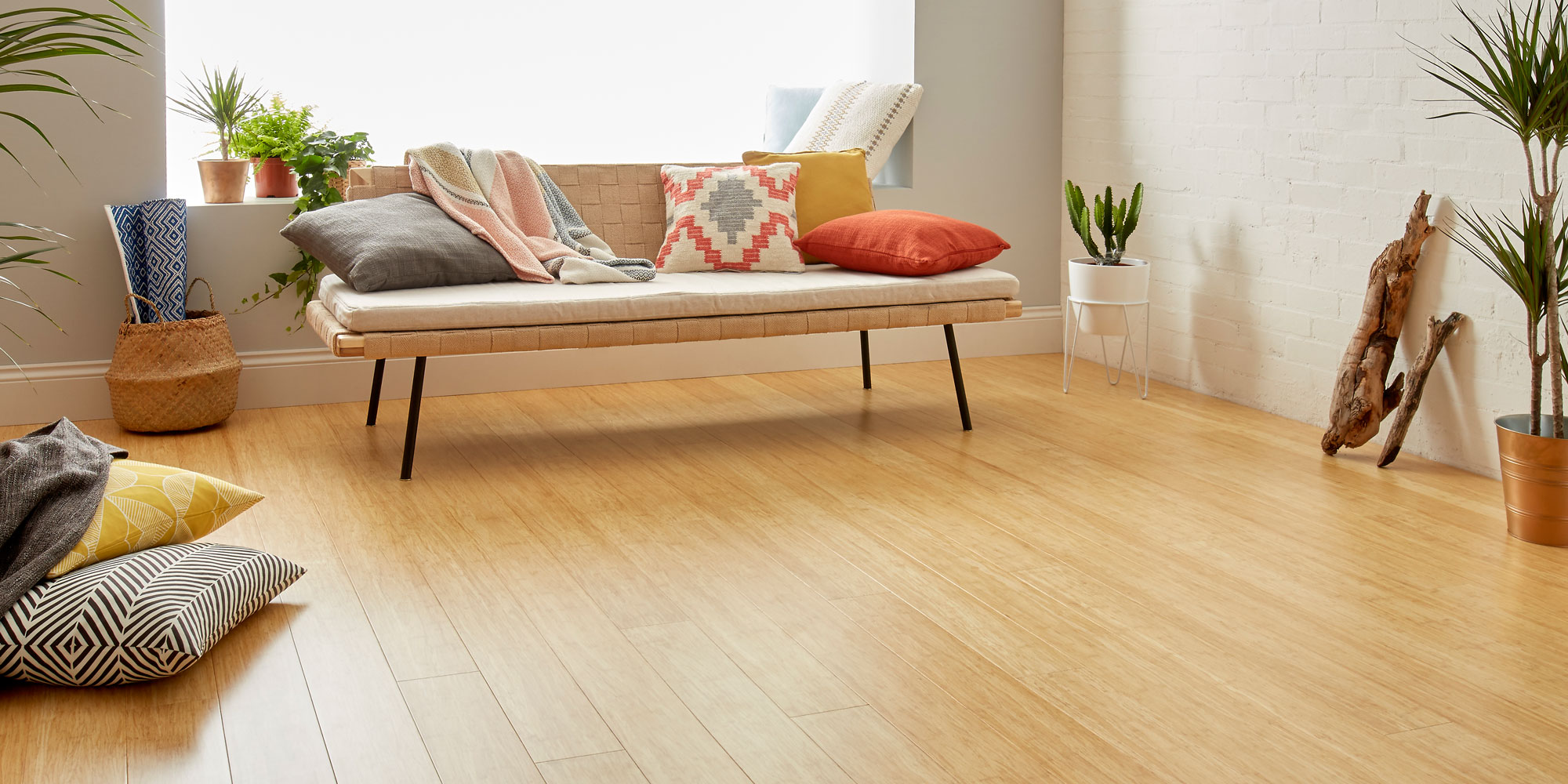
The natural color of bamboo is a light, sunny golden shade which makes an easy complement for many interior styles. Yet, everybody has their own tastes and bamboo flooring is available in other colors to suit these. Alternative shades can be achieved by treating the flooring in a process called carbonization or by staining the surface.
Carbonization
The carbonization process involves steaming the bamboo under extreme temperatures. This causes the sugars inside the porous plant to caramelize and transform in color to a coffee-like brown hue. The main advantage of carbonized bamboo is that the tone runs right through the entire product. This means that a small scratch or dent wouldn’t reveal a different color deeper in the floor.
Something to bear in mind is that bamboo does lose some of its strength following the carbonization process meaning it doesn’t rate as hard as its natural strand-woven alternative. Yet, tough finishes provide protection to the surface of the floor and ensure that carbonized bamboo is still more than practical for laying in all the typical areas of the home.
Discover the deep caramel color of carbonized bamboo in our Oxwich Coffee Strip and Oxwich Coffee Strand planks.
Stained Bamboo
Bamboo flooring can also be stained to various color shades, accommodating the stain on its surface just like a hardwood does. The bamboo’s natural features and textures remain visible from beneath the stain, capturing an appealing effect which can create real statement in the home.
Saddle and Whitewash are our stained bamboo floors.
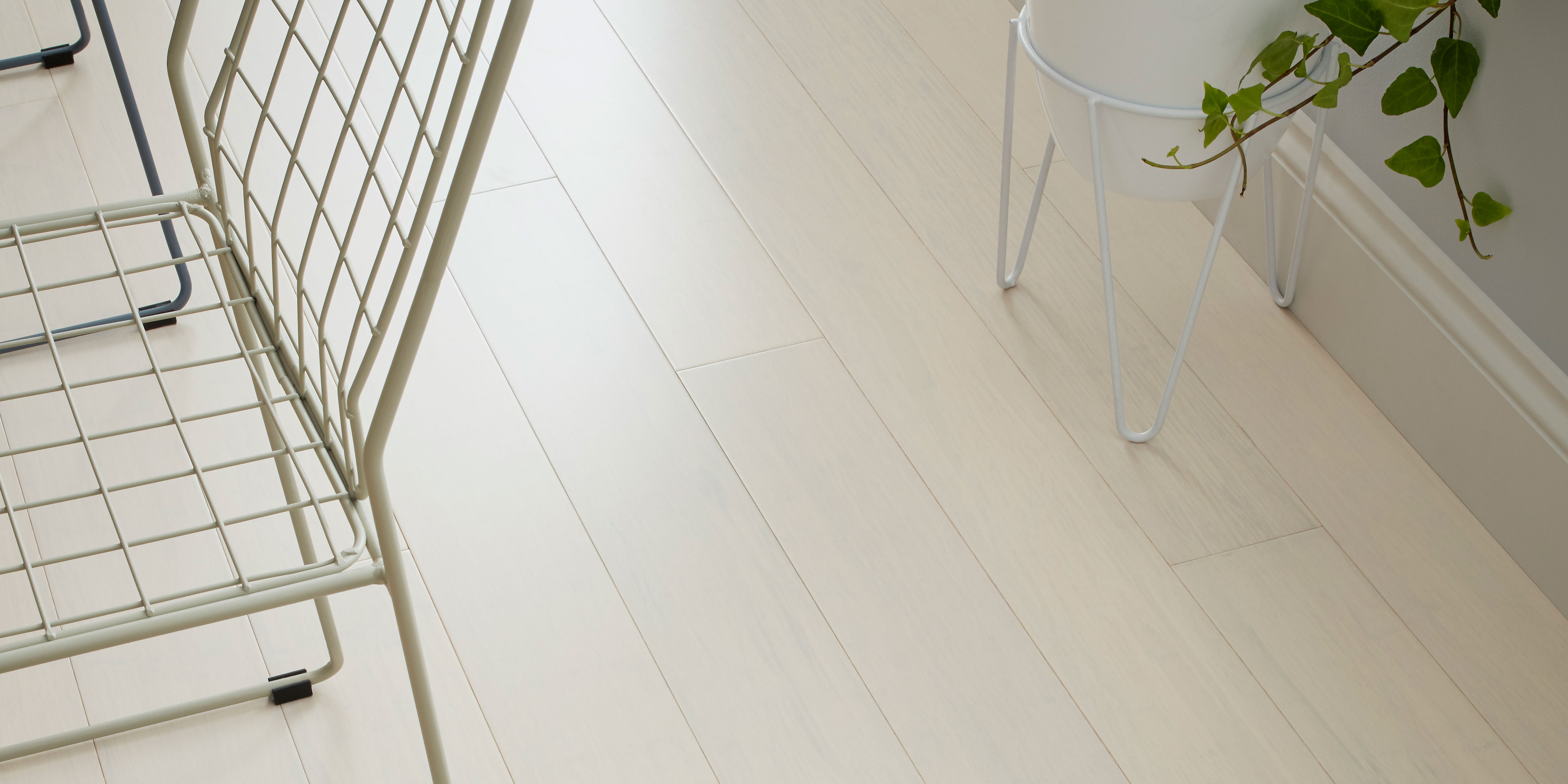
How is Bamboo Flooring Fitted?
Just like hardwood, bamboo flooring can be fitted in a number of different ways and the fitting system all depends on the type of bamboo floor and the supplier! Woodpecker laminated and horizontal bamboo floors include a traditional tongue and groove joint – a system commonly used with solid wood floors and the most recognized fitting system to the trade.
The tongue and groove system enables each plank to be neatly locked together and glued either between the joints or stuck directly to the subfloor. Tongue and groove planks can also be nailed down to a timber subfloor or joists.
Woodpecker Oxwich Strand Bamboo is fitted differently with a glueless clic system that enables the planks to be locked together and floated over an underlay without the need for any adhesive. This allows for a quicker installation which is also slightly less messy and allows to the floor to be used immediately after installation.
How is bamboo flooring finished?
Commonly used wood finishes are applied to bamboo flooring for extra protection and durability. A strong Urethane finish coats Woodpecker bamboo flooring, adding a dull sheen to the surface which doesn’t take away from the floor’s natural look. Every floor in our Oxwich collection receives 5 coats of the Urethane, providing excellent resilience against scratches, spills and stains.
What are the benefits of bamboo flooring?
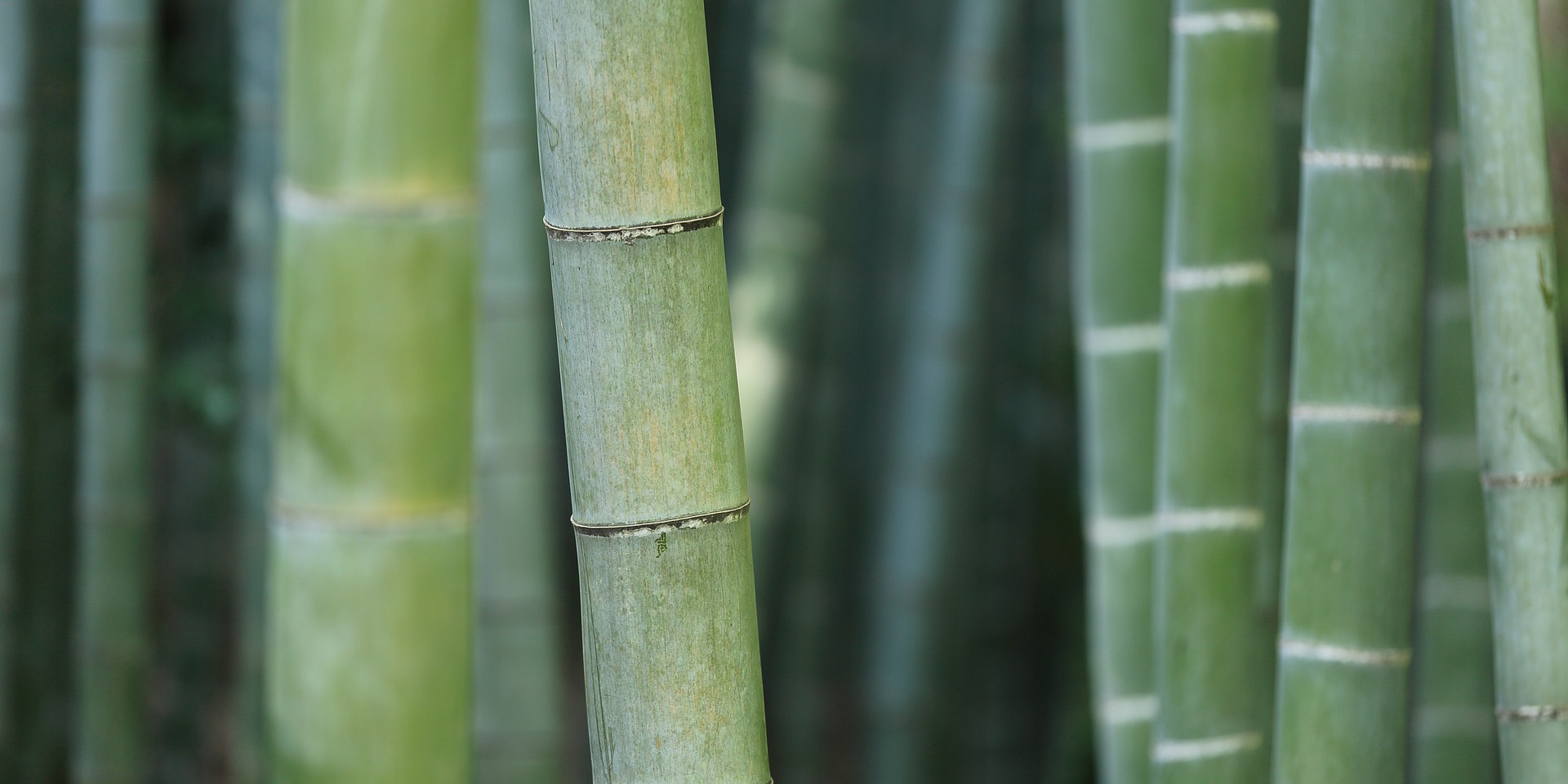
Availability
The most obvious eco-friendly benefit of bamboo flooring is its availability. As touched on earlier in this post, the bamboo plant naturally regenerates within a period of 5 years, allowing up to 25% of a forest to be harvested every year without decreasing the size of a plantation. One of the main reasons bamboo is so available is because it grows well in soil of poor quality and is self-propagating: able to flourish well without chemical treatments. It also spreads easily, needing little water or care and is able to persevere in some of the most extreme climatic conditions.
What’s more, the bamboo plant isn’t actually killed during harvesting. One bamboo plant consists of several poles and new shoots grow from the mother plant every year. Harvesting the poles also helps to improve the yield of the forest: as the older stems are removed, the younger bamboo is given more space for growth.
Bamboo is the fastest growing plant on our earth and one of the most sustainable resources the planet knows of today.
Sourced from Well-Managed Forests
The Moso bamboo forests which are harvested for Woodpecker bamboo flooring are stringently looked after to ensure the sustainability of the bamboo. In fact, the bamboo reserves in China are so significant and well managed that the forests are growing at a healthy rate of 5% annually. Plus, we only source from Forest Stewardship Certified (FSC) plantations. Their goal is ours: to ensure that forests can meet the needs of the present generation without compromising those of the future. By making it our responsibility to source our bamboo with care, we can be can be confident that we’re bringing you a beautifully and ethically sourced floor to enjoy in your home.
Little Waste Involved in Manufacturing
The process of creating flooring from bamboo is one that involves minimal waste. All of the cane’s stalk can be manufactured with the milled strips producing vertical or horizontal bamboo and the waste fibres processed into the strand-woven type.
Durability
Durability is often an overlooked factor of sustainability. The longer a floor lasts then the lower the environmental impact in terms of replacement. All types of bamboo flooring offer excellent hardness which can provide a sturdy floor for more than a lifetime. In fact, the plant has an intrinsically strong molecular structure with a tensile strength that’s actually stronger than steel!
Appearance
Bamboo flooring has a distinct look which is much different to that found in hardwoods. Many people prefer this more unusual appearance in their home and enjoy the idea that their flooring is sourced from exotic forests. As bamboo is available in its natural or carbonized colors, together with stained shades, there’s also a lot of flexibility when it comes to choosing the flooring, with a shade to suit any interior style.
Easy to Clean
While the finish of bamboo flooring adds protection and durability, it also provides a surface that’s easy to maintain. The flooring can be cleaned just like a hardwood with regular sweeping or vacuuming and the occasional damp mop using a suitable cleaning solution.
Healthy
Bamboo naturally contains an anti-bacterial agent known as Bamboo Kun. This eliminates up to 70% of bacteria which attempts to grow on the plant making for floor that naturally helps to ward off germs in the home.
Suitable for Underfloor Heating
All types of bamboo flooring are suitable for laying over underfloor heating and have a tog rating well within the recommended limit which allows for good heat transfer.
Suitable for Almost Anywhere in the Home
Bamboo flooring can add edgy style to almost any room in the home including living rooms, hallways, kitchens, bedrooms and studies. The only room in which we don’t recommend laying bamboo is the bathroom. This is because, just like hardwood, bamboo is susceptible to expansion and shrinking with sudden changes in humidity. The regular fluctuations in temperature and moisture that are typical of the bathroom are a threat to destabilizing the flooring and could result in cupping or gaping between planks.
Incorporating Bamboo Flooring into your Home

Bamboo’s unusual look can easily bring exotic spirit to a room. Its patterns and features make it the perfect choice for those who enjoy something a little more unique. Read on to learn how you can incorporate the ideal type of bamboo flooring into your interior or how you can enrich the flooring’s exotic edge with furnishings and accessories.
Choosing a Type of Bamboo
- Vertically laminated bamboo is the cleanest and most sophisticated style of bamboo flooring with minimal features and an even tone. It’s suited to contemporary interiors with bold colors and modern furnishings or can make a calm base for rooms busy with patterns and traditionally ornate features.
- Horizontally laminated bamboo is more detailed in appearance, revealing the knuckles and growth rings in the bamboo cane. This type lends itself as a busier base to pared-back interiors with clean lines and minimal colors or complements tropical-themes that can sit well with the floor’s natural feel.
- Strand-woven bamboo makes great company for the traditional or modern interior which could benefit from an exotic twist. The fine mixed fibers create a vision of varying shades across the floor and yet the overall look is consistent and understated. Out of the three types, strand woven is the most similar in appearance to hardwood floors with its fibers capturing a look that’s alike to wood grains.
Choosing a Colour of Bamboo
- The natural bamboo shade has a fairly neutral tone which is easy to pair with pastels, bold brights and darker schemes. It’s the easiest shade to introduce to highly defined interior style and also offers the versatility of changing your decor without the risk of a clash.
- Carbonised bamboo with its rich coffee color is suited to warm interiors with bold color themes. The shade makes striking company for ochre, clementine and coral while enthusing brilliant contrast with bright white.
- Stained bamboo has a quirky, modern feel which lends itself to contemporary interiors. Woodpecker Oxwich Whitewash is perfect for Scandinavian-style settings with pastels and light woods while Oxwich Saddle can create a luxurious contrast in bright schemes.
Choosing Bamboo for your Room Size
- Working with a small space? Opt for bamboo in its natural color or in a light stain to help lift the light in the room and create the idea of a larger area.
- Working with a large space? Choose carbonized bamboo or a dark stain to add contrast, depth and a feeling of warmth.
Dressing Up Your Bamboo Floor
Love the idea of introducing a rich exotic feel into your home? Then bring the best out of your bamboo flooring by adding a distinct style of furniture and accessories. Complement the idea of a far-eastern sourced material with ethnic patterns, jeweled cushions and lanterns. Add further exotic zest with tropical motifs, pouffes, wicker baskets and ornamental stand-out pieces.
On the walls, go for bold colors such as navy, coral, emerald, jade and burnt orange. Add feature patterned wallpaper and layer up with curious art, plants and lighting to create depth.
For a more contemporary vibe, keep walls neutral and inject splashes of the tropics in the form of palm leaf wallpaper, pineapple objects and animal motif cushions. Pair these features with contemporary designer furniture for an even more up-to-date spin on the exotic feel.
Thanks for reading!
We’ll finish off with some amazing facts about Bamboo:
- Thomas Edison’s first light bulb used a bamboo filament.
- Bamboo survived the atomic bomb blast in Hiroshima in 1945 and was the first plant to re-green following the eruption.
- Bamboo provides housing to more than 1 billion people in the world.
- Cooked bamboo shoots have been a common part of Asian cuisine for centuries.
- Bamboo releases 30% more oxygen than the equivalent area of trees.
- Bamboo has been used as an ancient herbal medicine for thousands of years in Asia.
- Natural, un-boiled strips of bamboo are poisonous for human consumption.
- Bamboo has a tensile strength stronger than steel.
- Bamboo is an essential component of earthquake architecture, specified for its ability to tolerate high levels of stress and movement.
- Bamboo is vital to the survival of hill tribes in Thailand. They use it for everything from building houses, to making tools, to food.
The complete range of Woodpecker bamboo flooring is available to browse online. Head here to see the Oxwich collection.

